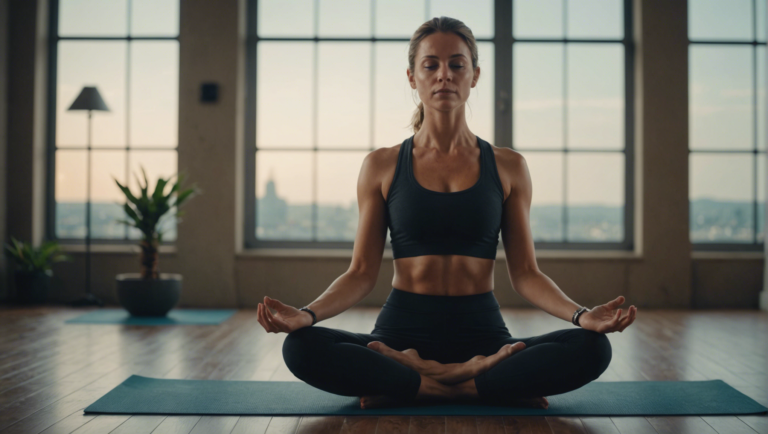Discover The Yoga Styles That Burn The Most Calories
Exploring High-Calorie-Burning Yoga Styles: A Journey Beyond Traditional Practices
Yoga, traditionally viewed as a practice centered around tranquility and mindfulness, also offers dynamic styles that can significantly elevate calorie burning. These vigorous forms of yoga challenge the body, fostering strength, flexibility, and endurance, while also encouraging mental clarity and focus. This article delves deep into the world of high-calorie-burning yoga styles, shedding light on less traditional practices that provide both a meditative experience and a substantial physical workout.
Unveiling the Power of Vinyasa Flow
Vinyasa Flow stands out for its smooth transition between poses, maintaining a consistent, moderately high heart rate. This style is characterized by synchronized breath and movement, which facilitates a deep physical and mental connection. Sessions typically vary in intensity and sequence, making Vinyasa an adaptable practice suitable for many, with the potential to burn around 400 to 600 calories per hour.
The Intensity of Bikram Yoga
Bikram Yoga, known for its fixed sequence of 26 poses performed in a heated room, dramatically increases calorie expenditure. The high temperature, often around 105°F with 40% humidity, encourages the body to sweat profusely, enhancing detoxification and flexibility. This practice can torch approximately 500 to 700 calories per session, depending on individual effort and metabolic rate. The challenging environment and consistent routine push practitioners to their limits, both physically and mentally.
Ashtanga Yoga: A Rigorous Discipline
Ashtanga Yoga, with its six series of increasing difficulty, is a practice permeated by discipline and high energy expenditure. This method involves rapidly moving through a set sequence of poses, powered by the Ujjayi breathing technique. The continuous flow and muscular engagement required make Ashtanga not only a test of physical endurance but also a pathway to inner peace. Practitioners can expect to burn in the vicinity of 500 to 700 calories per hour, with the amount increasing as they progress to more advanced series.
Power Yoga: Strength and Flexibility
Power Yoga, a Western adaptation of Ashtanga Yoga, emphasizes strength and flexibility. This style lacks a set sequence, giving instructors the freedom to create challenging sessions that can include traditional lifting movements, such as squats and pushups, incorporated into the flow. This adaptability makes Power Yoga appealing to a broad audience, including those accustomed to high-intensity workouts. Depending on the session’s intensity, individuals can burn approximately 300 to 600 calories per hour.
Core Strength Vinyasa Yoga: Transformative Energy
Core Strength Vinyasa Yoga introduces a fresh approach by focusing on the body’s core, utilizing poses that activate the deep torso muscles. This style encourages practitioners to move from their center, leading to improved posture and muscle tone while boosting calorie burning. The dynamic nature of Core Strength Vinyasa ensures a comprehensive workout that strengthens both the body and mind, with calorie expenditure comparable to that of Vinyasa and Power Yoga.
Forging a Personal Connection to Yoga
While the physical benefits of high-calorie-burning yoga styles are apparent, the mental and spiritual enhancements contribute to the holistic well-being of practitioners. Embracing a style that challenges both the body and mind fosters a deeper connection to yoga’s essence, transcending the mere act of calorie burning. The journey through these vigorous practices is as much about cultivating inner strength and resilience as it is about enhancing physical health.
Navigating the Path to Wellness
In exploring high-calorie-burning yoga styles, enthusiasts embark on a rewarding journey that extends beyond traditional practices. Whether preferring the heated challenge of Bikram, the discipline of Ashtanga, the dynamic flow of Vinyasa, the strength focus of Power Yoga, or the core engagement of Core Strength Vinyasa, there exists a path for every individual. This adventure not only promotes significant calorie burning but also invites a deeper exploration of personal limits, mindfulness, and holistic health, providing a balanced approach to wellness in today’s fast-paced world.
The Synergy of Strength and Flexibility: Power Yoga’s Role in Weight Management
Yoga, a millennia-old practice known for promoting peace and mindfulness, has evolved into diverse styles, with power yoga emerging as a beacon for those seeking the dual benefits of strength and flexibility. It stands out as a vigorous workout that blends the spiritual and physical aspects of yoga, proving itself as a key player in weight management strategies.
The Fusion of Strength-Building and Flexibility
Power yoga is a dynamic form that encourages a higher calorie burn than traditional yoga practices due to its fast-paced, intense nature. This vigorous approach makes it an effective tool in weight management and muscle toning, as it combines cardiovascular workout with strength training. The sequences are designed to challenge the body, building muscle strength through poses that engage multiple muscle groups simultaneously.
Elevating Metabolic Rate through Vigorous Movement
The sequences in power yoga are crafted to maintain a rapid flow, significantly elevating the heart rate. This cardiovascular component is crucial for burning fat and boosting metabolism, making it an excellent option for those looking to manage their weight effectively. The sustained practice of power yoga can lead to an enhanced metabolic rate, even at rest, contributing to more efficient energy use and fat burning.
The Role of Breathing in Enhancing Weight Loss
Breathing plays a pivotal role in the practice of power yoga, not just as a means of maintaining rhythm but also in enhancing the weight loss process. The intense focus on breath control helps to oxygenate the blood, improve circulation, and increase the efficiency of the body’s energy use. This focused breathing encourages the elimination of toxins and boosts the body’s internal fat-burning capabilities.
Flexibility and Recovery as Catalysts for Weight Management
While power yoga emphasizes strength and endurance, it also significantly improves flexibility. This enhancement in flexibility reduces the risk of injuries, allowing for more consistent and prolonged engagement in physical activities, including yoga itself and other forms of exercise. The practice aids in muscle recovery and relaxation, ensuring that practitioners can maintain a regular, injury-free workout regimen.
Creating a Sustainable Lifestyle Change
Power yoga transcends being merely a physical exercise; it is a holistic approach to health and well-being. The practice encourages mindfulness and stress reduction, which are crucial elements in making sustainable lifestyle changes, especially concerning diet and exercise habits. Engaging in power yoga can lead to a more mindful approach to eating and a balanced perspective on lifestyle choices, which are essential for long-term weight management.
Harnessing the Synergy for Optimal Results
To fully benefit from power yoga in the context of weight management, it is advisable to integrate it into a broader fitness and nutrition plan. While power yoga can significantly contribute to weight loss and muscle toning, combining it with other forms of exercise and a balanced diet enhances its effectiveness. This integrated approach ensures comprehensive health benefits, including increased strength, improved flexibility, and better overall body composition.
The journey of weight management and fitness is personal and varied, with power yoga offering a potent blend of physical exertion and mental focus that addresses both the body and the mind. Its role in promoting strength, flexibility, and a mindful approach to health makes it a valuable tool for anyone looking to manage their weight effectively. By embracing the principles of power yoga, individuals can embark on a path toward achieving their fitness goals while nurturing a peaceful mind and a resilient body.
Unveiling the Intensity of Hot Yoga: A Deep Dive into Caloric Burn and Detoxification
The Essence and Efficacy of Hot Yoga in Caloric Burn
Hot yoga, a practice that has surged in popularity over the past few decades, pushes the boundaries of traditional yoga by incorporating high temperature and humidity levels. This variation of yoga, often conducted in a room heated to around 105 degrees Fahrenheit with about 40% humidity, claims to offer enhanced benefits over its cooler counterparts, including superior calorie burn and detoxification effects. Analyzing these claims requires a deep dive into the physiological impacts of practicing yoga under such intense conditions.
Exploring the Caloric Burn of Hot Yoga
One of the most alluring aspects of hot yoga is its potential for increased calorie expenditure. The elevated temperature of the environment causes the body to work harder to cool itself, thereby increasing heart rate and metabolic rate. This physiological response mimics the effects of moderate-intensity aerobic exercises, thus theoretically leading to a higher calorie burn compared to yoga practices in normal temperatures.
Research and anecdotal evidence suggest that an individual can burn anywhere from 500 to 1,000 calories in a 90-minute session, depending on factors such as body weight, effort level, and metabolic rate. This range is significantly higher than that of most traditional yoga practices, making hot yoga an attractive option for those seeking to maximize their exercise efficiency.
The Detoxification Debate
Detoxification through sweating is another often-touted benefit of hot yoga. Proponents argue that the intense sweating induced by the high temperature helps flush toxins from the body. However, this claim warrants scrutiny. The primary function of sweat is to regulate body temperature, not to detoxify. While it’s true that sweat contains small amounts of toxins, the liver and kidneys are the organs primarily responsible for detoxification.
That said, the act of sweating can improve skin health by unclogging pores, which could indirectly contribute to the body’s natural detoxification processes. Moreover, the rigorous activity and deep breathing involved in hot yoga support the body’s circulatory and respiratory systems, potentially aiding in the elimination of toxins.
Balancing the Benefits with Potential Risks
While the calorie-burning and detoxifying effects of hot yoga are compelling, it’s crucial to approach this practice with awareness of its potential risks. The high heat can lead to dehydration, heat stroke, and overstretching of muscles. Individuals with certain health conditions, such as cardiovascular issues or heat sensitivity, should consult with a healthcare provider before diving into hot yoga.
Maintaining proper hydration before, during, and after a session is paramount. Participants are also advised to listen to their bodies, taking breaks and modifying poses as necessary to avoid overexertion.
Holistic Approach to Health and Fitness
Hot yoga into one’s fitness regimen can undoubtedly contribute to a holistic approach to health and fitness. It combines the physical benefits of exercise with the mental and emotional benefits of yoga, such as stress reduction and improved mental clarity. However, diversity in exercise routines is key to achieving a well-rounded level of fitness. Hot yoga should be considered one component of a broader health strategy that includes a variety of aerobic, strength, and flexibility activities.
Final Advice for Prospective Hot Yoga Practitioners
For those intrigued by the high-intensity environment of hot yoga, starting with an open mind and a cautious approach is advisable. Beginners should familiarize themselves with basic yoga poses and principles in a cooler setting before transitioning to the heated environment. Choosing a reputable studio with experienced instructors can also provide a safer and more supportive introduction to the practice.
Engaging in hot yoga presents an opportunity to push physical and mental boundaries, fostering a deeper connection with one’s body. As with any fitness endeavor, personal experience is the ultimate guide. By paying close attention to how their body responds, practitioners can harness the unique benefits of hot yoga while mitigating its risks, paving the way for a healthier, more balanced lifestyle.
Vinyasa Yoga: The Dynamic Flow That Energizes and Trims
In the vast and varied world of yoga, one style that stands out for its ability to blend dynamism with mindfulness is Vinyasa Yoga. Known for its flowing sequences that transition smoothly from one pose to the next, Vinyasa Yoga offers a unique combination of strength, flexibility, and stamina building. It’s a practice that not only energizes the body but also trims and tones, making it a favored choice for those looking to enhance their fitness while maintaining a deep connection with their breath and inner state.
The Essence of Vinyasa Yoga
Vinyasa Yoga is characterized by its focus on the synchronization of movement and breath. Each movement is paired with an inhale or exhale, creating a dance-like flow that invigorates the body and calms the mind. This continuous flow of movement increases the heart rate, providing a cardiovascular benefit uncommon in more static styles of yoga. The dynamic nature of Vinyasa challenges the muscles, leading to improved strength, flexibility, and endurance.
The Caloric Burn of Vinyasa
One of the most compelling aspects of Vinyasa Yoga for fitness enthusiasts is its potential for calorie burn. Due to its continuous and active movement, Vinyasa Yoga can burn a significant number of calories, rivaling traditional forms of exercise such as light jogging or swimming. The exact number of calories burned will vary based on factors such as body weight, intensity of the practice, and the individual’s metabolic rate, but it’s clear that Vinyasa stands out among yoga styles for its energy expenditure potential.
Body and Mind Connection
Beyond the physical benefits, Vinyasa Yoga offers profound mental and emotional advantages. The requirement to stay present and connected with the breath amidst the flow creates a meditative state, reducing stress and improving mental clarity. This mindfulness aspect encourages practitioners to bring attention to their movements and the sensations within, promoting a deeper connection to the body and a sense of inner peace.
Customizing Your Vinyasa Practice
Vinyasa Yoga is highly customizable, making it accessible to beginners and challenging for advanced practitioners alike. The sequences can be modified to suit individual fitness levels, with options for simpler or more complex poses. This adaptability not only ensures safety and comfort but also allows for continuous progression and variety in one’s practice, keeping it engaging and effective over time.
The Integration of Breath and Movement
The cornerstone of Vinyasa Yoga is the seamless integration of breath and movement. This conscious breathing energizes the body and helps in maintaining focus during challenging sequences, enhancing both physical performance and mental concentration. The emphasis on breath work also supports the detoxification process, promoting overall health and well-being.
The Role of Vinyasa in Holistic Fitness
Vinyasa Yoga plays a vital role in holistic fitness, offering a comprehensive workout that addresses multiple components of physical health, including strength, flexibility, and cardiovascular conditioning. Furthermore, its emphasis on mindfulness and stress reduction contributes to emotional and mental health, showcasing the truly encompassing nature of the practice.
Getting Started with Vinyasa Yoga
For those interested in exploring Vinyasa Yoga, starting with a beginner’s class or online tutorial is recommended. This allows for an understanding of the basic poses and flow techniques in a supportive and guided environment. As proficiency increases, practitioners can explore more advanced classes, further challenging their bodies and deepening their practice.
Vinyasa Yoga represents a dynamic and holistic approach to fitness, where the cultivation of physical health and mental serenity goes hand in hand. Its combination of movement, breath work, and mindfulness creates a unique and powerful practice that energizes, trims, and transforms. Whether you’re a seasoned yogi or new to the practice, Vinyasa Yoga offers a path to greater well-being, proving that the journey of yoga is not just about the poses—it’s about how you flow through life.
Beyond the Mat: Incorporating Cardio Yoga for Ultimate Fat Loss and Endurance Building
The fusion of yoga with elements of cardiovascular exercise is transforming the way fitness enthusiasts approach their routine. Merging the meditative and flexibility-enhancing benefits of traditional yoga with the heart-rate-boosting power of cardio creates a holistic workout that not only aims at fat loss but significantly improves endurance. This innovative approach transcends the conventional yoga practice, inviting an explorative journey into the realms of strength, stamina, and spiritual clarity.
The Dynamic Duo: Yoga and Cardio for Enhanced Fat Burning
Yoga, inherently known for its ability to foster deep connections between the mind, body, and spirit, reveals an untapped potential when intertwined with cardio. This synergy accelerates fat burning by increasing the metabolic rate, engaging multiple muscle groups simultaneously. Power yoga and Vinyasa flow are prime examples, where rapid movements are seamlessly integrated into the practice, elevating the heart rate and promoting a vigorous calorie burn.
Amplify Your Endurance with Cardio-Infused Yoga
Endurance is the cornerstone of any comprehensive fitness regime. The continuous flow of movement, characteristic of cardio-infused yoga, challenges the body’s stamina and resilience. As practitioners navigate through sequences at an accelerated pace, they cultivate not only muscular strength but also cardiovascular endurance, making daily activities and other forms of exercise more manageable and less taxing.
Reaping the Wholistic Benefits
The amalgamation of yoga and cardiovascular exercise yields benefits that surpass physical transformation. On a physiological level, this combination enhances blood circulation, boosts immune function, and promotes effective oxygenation of body tissues. Psychologically, it improves mood, decreases stress, and elevates energy levels, contributing to an overall sense of well-being.
Tailoring Your Practice for Optimal Results
Adapting this dual-practice to fit personal fitness goals is key. For individuals new to this method, starting with lower-intensity yoga styles, such as Hatha, and gradually incorporating short bursts of high-intensity movements can set a solid foundation. Seasoned practitioners may opt for more advanced yoga styles, like Ashtanga or high-intensity interval training (HIIT) yoga, to further challenge their endurance and accelerate fat loss.
Nurturing the Balance Between Discipline and Mindfulness
While the primary focus of integrating yoga with cardio is to enhance physical fitness, it is essential not to overlook the spiritual and mental health benefits. Maintaining mindfulness throughout the practice helps nurture a sense of inner peace and discipline, crucial elements for sustaining a balanced and healthy lifestyle.
The evolution of yoga into a comprehensive workout that includes cardiovascular exercise offers a refreshing perspective on achieving fitness and well-being. By embracing this approach, individuals can enjoy the dual benefits of fat loss and improved endurance, all while retaining the essence of yoga as a holistic discipline for mind, body, and spirit enrichment. This innovative practice not only reshapes the body but also reinvigorates the soul, marking a new era in the pursuit of ultimate fitness and wellness.
Conclusion
Embarking on the quest to uncover yoga styles that maximize calorie burn invites a fascinating exploration beyond the serene and meditative reputation that yoga traditionally holds. It’s a journey that leads aspirants through a transformative process, merging the ancient practice with modern fitness needs to create a holistic and dynamic approach to health and well-being.
At the forefront of this evolution is Power Yoga, a vigorous form emphasizing strength and flexibility. It stands as a testament to the adaptability of yoga, evolving to meet contemporary fitness goals while retaining its core essence. Power Yoga challenges practitioners to push their limits, facilitating not just weight management but also fostering a deeper connection between mind, body, and spirit. The synergy of muscular strength and flexibility culminates in a practice that does more than burn calories; it enhances overall physical resilience and mental fortitude.
The intensity of the practice escalates with the introduction of Hot Yoga, which takes the calorie-burning potential to new heights. By performing yoga poses in a heated room, the body works harder to cool itself, significantly increasing the number of calories burnt. This practice also promotes detoxification, as the sweat helps flush toxins from the body. But the benefits of Hot Yoga extend beyond the physical, providing a mental challenge that teaches practitioners to find calmness and focus in uncomfortable situations, preparing them for life’s adversities.
Vinyasa Yoga, with its continuous flow of movement synchronized with breath, offers another avenue for those seeking to enhance their fitness. This dynamic style keeps the heart rate elevated, promoting cardiovascular health and endurance. The fluid transitions from one pose to another ignite the body’s metabolic engine, burning calories long after the session has ended, making Vinyasa an effective tool for weight loss and muscle toning.
Further expanding the boundaries of traditional yoga, Cardio Yoga emerges as a fusion that incorporates aerobic elements into the yoga practice. This approach not only accelerates fat loss but also builds endurance, offering a comprehensive workout that addresses both anaerobic and aerobic fitness needs. Cardio Yoga represents the merging of worlds, where the mindfulness and flexibility of yoga meet the intensity and energy of cardiovascular exercise, creating a balanced and invigorating experience.
This exploration of high-calorie-burning yoga styles marks a significant shift in how we perceive and practice yoga. It underscores the practice’s versatility and its ability to adapt to the changing landscapes of fitness and wellness. By integrating elements of strength, flexibility, cardiovascular health, and mental resilience, these yoga styles offer a comprehensive approach to well-being that goes beyond mere calorie burn. They invite practitioners to not only transform their bodies but also to cultivate a more profound sense of self-awareness and inner strength.
As we venture beyond the mat, it becomes clear that the true essence of yoga in the context of calorie burning and weight management is not about the intensity of the practice but the intention behind it. These styles, from Power Yoga to Cardio Yoga, serve as avenues for individuals to explore their physical boundaries, challenge their perceptions, and ultimately, to discover a practice that resonates with their personal health and wellness goals.
Therefore, the journey to discover the yoga styles that burn the most calories is more than a pursuit of physical fitness; it is an invitation to embark on a transformative path that fosters holistic health. It’s an exploration that encourages practitioners to blend tradition with innovation, to find balance and harmony, and to realize that the ultimate goal of yoga—regardless of the style—is to cultivate well-being, resilience, and a deep, enduring connection to the self.




